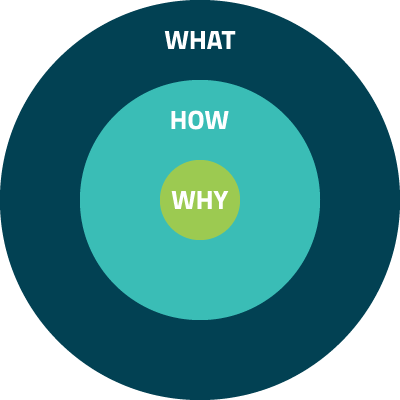I’ll admit it. I have a 3 year old at home and nothing drives me more crazy than when she asks “Why?" five times in a row. Don’t get me wrong, I love her curious mind—I just wish her list of questions wasn’t so infinite. But, that’s at home. At work, I require our team to ask why, especially when it comes to strategy and marketing.
Over the years, we’ve asked “why” a lot. And we’ve found that the best answer is usually the one that gets down to the real root of the problem. But you can’t find the core issue without asking why.
What happens when you don’t ask why? We don’t dig deeply enough while determining what work needs to be done. And that means we only see the surface problem. The result? Even if marketers have the best of intentions, clients end up with band-aids instead of real solutions..
But, when you systematically ask yourself or you team why something is done, those surface problems and layers of faux issues get stripped away, until only the core issue remains. That’s when real solutions can start coming to life. Even though the end result may look different than what was originally pictured, we arrive at a more successful solution because we’re addressing the real problem.
The book Start with Why is one that we reference a lot around here. Simon Sinek talks about how customers don’t buy products because of features but because they believe the same things the company believes.
Look at Nike, with the tagline “Just do it.” Now, you can buy shoes from any shoe company but Nike connects with the customers who believe in putting everything aside and just doing it. No excuses. Whether or not they make the best product on the market is irrelevant. Their message resonates with dedicated gym rats, couch potatoes who want to be gym rats and everyone in between.
You don’t have to be a big brand for this to work either. You just have to know why your company is doing what it’s doing. We take Simon’s three-step approach in one of the exercises we use in crafting brand alignment strategies for companies:

Start at the center and ask yourself, why do we do what we do? You may not get it the first time. That’s okay. In practice, we generally dig deep at least 5 times before we truly uncover some of these answers. Once you get to the “How” step. you have to answer, “How are you delivering this belief?” Not by listing products or features, but through things that are at the core of your business. The “What” can generally be a more tangible product or service that you offer.
Simon Sinek uses these 2 examples. Can you tell which one connects with the audience more?
Apple computers taking the “Why approach”:
Why: They believe in thinking differently
How: Through innovation, high quality materials made to work together, highly designed products
What: They make computers
Computer company taking the “What approach”:
What: We sell computers
How: They are inexpensive and run software
Why: Wanna buy one?
The Apple approach attracts people who think like they think and believe what they believe. The other example shows marketing that takes the “What approach” and focuses on cost. In the beginning, Apple created a cult following of people that believed the same things they did. They didn’t appeal to everyone, but they were proving their market with the people who agreed with the reason why they made computers.
Whether or not you’re doing a brand redesign or a sales sheet, going back to “Why” will allow you to dig deep into your problems and find the best solutions. I challenge everyone to be more like my three year old and ask why (at least) five times before you execute anything.
Subscribe to Our Blog
Stay up to date with the latest marketing, sales, and service tips.



